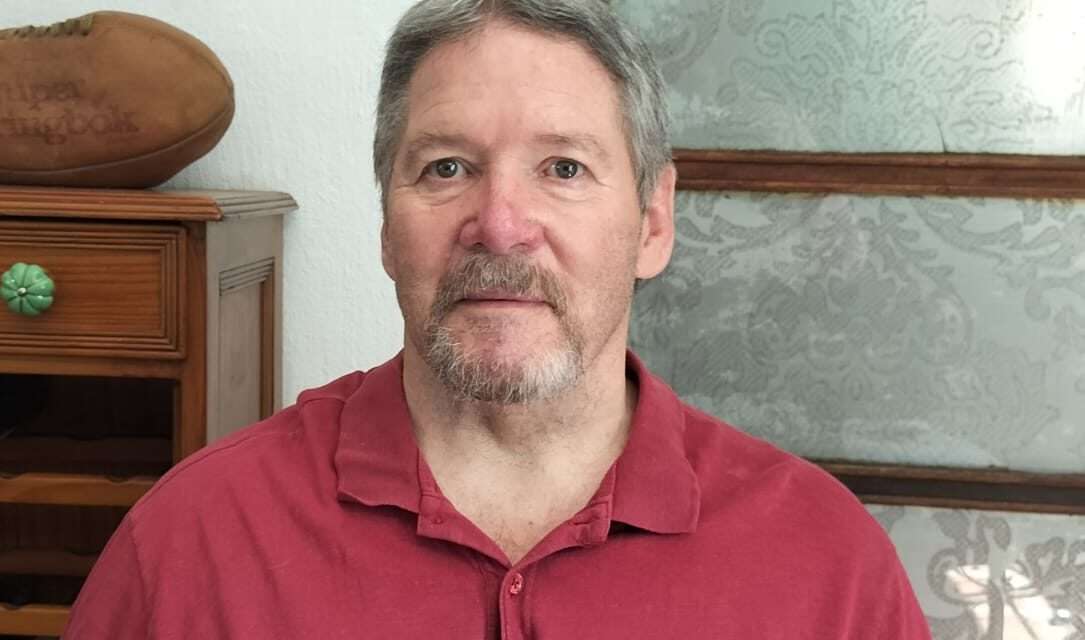The writer of this article is Dirk Kriel, a product of Goudveld High School in Welkom, a competitive rugby player and a former national serviceman at 6 SA Infantry in Grahamstown. Dirk spent the last five months of his military service on the Angolan border, just north of Rundu. “After completing my service, I was assigned to the Welkom Commando, where I participated in annual commando duties. During this time, I was also called up twice for three-month border service deployments. After completing my military service, I qualified as an Electrical Engineer, leading a happy and fulfilling life before being diagnosed with Parkinson’s disease in January 2018.”
“I am writing to share my deeply personal journey with Parkinson’s disease, a condition that has profoundly altered every facet of my life since then. There is no cure for this hateful progressive disease. This narrative seeks to illuminate the myriad challenges I face daily and to convey the significant impact this illness has on my physical capabilities, mental health, and overall quality of life. Through this account, I hope to highlight the seriousness of this disease, not only for fellow sufferers, but really to the families, friends and the general public who sometimes do not realise why this person acts “in this irritating way”.
- Understanding Parkinson’s disease: My very Basic Neurological Perspective
- To appreciate the full extent of Parkinson’s disease, it is essential to understand its effects on the brain. Understanding Parkinson’s disease requires a basic comprehension of how the brain functions and communicates. My journey with Parkinson’s has profoundly shaped my perspective on this condition and its effects on my life.
- The intricate network of approximately 86 billion neurons in the brain is responsible for facilitating our thoughts, actions, emotions, and bodily functions. In a healthy brain, these neurons communicate seamlessly through trillions of synapses. However, in Parkinson’s, this communication is disrupted, leading to a cascade of motor and non-motor symptoms that compromise my independence and quality of life
- In a thought-provoking YouTube video titled “The Brain Didn’t Evolve – A Psychiatrist Explains Why,” Dr. Dianne Grocott discusses, in laymen terms, the intricacies of the brain, emphasizing that it was designed rather than evolved. Her explanation provides valuable insights into the brain’s structure and communication methods.
- The brain is an incredibly complex organ, housing approximately 86 billion neurons and trillions of connections—far more intricate than any galaxy. Neuroscientists worldwide are tirelessly working on the monumental task of mapping each neuron and synapse connection in the human brain.
- Brain Structure and Function
- Brain Cells
- The brain consists of a vast number of cells. Brain cells has the body and there is a nucleus in there. Each neuron containing a unique DNA structure. Each DNA strand operates like a supercomputer, facilitating communication among neurons.
- Additionally, glial cells support these neurons by cleaning, organizing, and calming them, much like nursemaids assisting computers. These cells are organized into specific regions, each responsible for different functions.
- Combination of these little (but hugely intelligent) brain cells is arranged in regions in the brain.
- Regions of the Brain
- Frontal Lobe:
- This area acts as the brain’s CEO, overseeing executive functions such as decision-making and problem-solving.
- Temporal Lobe:
- Associated with emotional memory, this region plays a key role in processing and recalling feelings linked to past experiences.
- Parietal Lobes:
- Located at the top of the brain, these lobes are essential for coordination, movement organization, and spatial awareness.
- Frontal Lobe:
- Brain Cells
-
-
-
- The left parietal lobe controls the right side of the body, while the right side manages the left.
- Occipital Lobe:
- Found at the back of the brain, this region functions as the visual arts studio, organizing everything we see and integrating visual information
- Limbic System:
- Situated in the middle of the brain, this system regulates emotions and is crucial for survival and experiencing joy.
- Brainstem:
- This vital part is responsible for maintaining basic life functions, keeping us alive and functioning.
-
- Communication in the Brain
- Neurons communicate with each other through synapses, much like social media platforms. They chat among themselves, passing messages using neurotransmitters—small chemicals like dopamine, serotonin, and adrenaline, which act as emoji’s transmitting information.
- These regions connect through a vast network of cables, allowing for intricate communication pathways.
- If you google ‘’connectomes” they have done pictures of the connections between various parts of the brain, front to back, left to right, top to bottom and they colour code them.
- Pathways
- Researchers explore how different areas in the brain light up during specific tasks and identify pathways that motivate learning.
- There is a reward pathway, so if something happens and you feel good then the brain says how we can do this more and you learn.
- The brain operates with a default mode which is whirring away in the background when you are just relaxing, day dreaming or being creative.
- There is a task positive network which engage when focused on external activities.
- Neuron-Level Communication (From nerve cell to another nerve cell)
- Neurons communicate with each other through synapses, much like social media platforms. They chat among themselves, passing messages using neurotransmitters (small chemicals like dopamine, serotonin and adrenaline) which act as emoji’s transmitting information
- Synapsis are the junctions between neurons in the brain that allow them to communicate with each other. Each neuron has anywhere between a few to hundreds of thousands of synopsis connections
- Synopsis connect neurons in the brain to neurons in the rest of the body and from that neurons to neurons in the muscle.
- At the synapse, an electrical signal (action potential) from the presynaptic terminal is converted into a chemical signal (neurotransmitters release). The neurotransmitters then bind to receptors on the postsynaptic terminal, which can either excite or inhibit the neuron from firing.
- Synapsis can be electrical or chemical. Electrical synapsis are also called gap junctions and are less common than chemical synapsis.
- These regions connect through a vast network of cables, allowing for intricate communication pathways and then you have really long cords going from one place to another and electricity travel along that when you go to the next brain cell.
- If you just had electricity it will go poof and then you’ve recirculated your brain and that is not good and if all of them did that together you’d have an epileptic fit.
- The synapse, an electrical signal (action potential) from one neuron is transformed into a chemical signal through neurotransmitter release. These neurotransmitters bind to receptors on the receiving neuron, either exciting or inhibiting it from firing.
- Synapses can be electrical (gap junctions) or chemical, with the latter being more common. Each brain cell contains a nucleus that holds our DNA, and long axons transmit electrical signals between neurons.
- It’s crucial that brain cells regulate their communication to prevent chaotic activity, which could lead to seizures. The packets of neurotransmitters—each with specific shapes—are released when an electrical impulse travels down the neuron
- On the other side of the nerve you got some receptors, just the right size so that the dopamine basketballs go into the dopamine receptors and the serotonin into the serotonin receptors, allowing for precise communication between cells.
- Dopamine and Parkinson’s Disease
- Dopamine is a key neurotransmitter in Parkinson’s disease, a degenerative disorder affecting movement.
- This progressive condition results from the degeneration of nerve cells in the substantia nigra, a brain region that controls movement
- As these nerve cells die or become impaired, they lose the ability to produce dopamine, leading to various motor and non-motor symptoms.
- Parkinson’s disease presents a complex array of symptoms that can be categorized into motor and non-motor symptoms.
- Motor Symptoms affect areas such as but not limited to list below
- Affect movement and balance
- Postural instability, or difficulty balancing, is possible one of the major PD movement symptoms which can lead to falls
- Tremors
- Originally I began experiencing light tremors in my left hand which was one of the first indicators that something is wrong.
- PD tremors are not constant and can come and go throughout the day.
- Sometimes, my tremors become so pronounced that I struggle with fatigue.
- Stressful situations can exacerbate these tremors significantly.
- Every time I am confronted in a stressful or condescending manner my tremors increase.
- Affect movement and balance
- Rigidity (stiffness) is a key symptom of Parkinson’s disease
- Rigidity is when muscles become stiff or inflexible resulting in my incapability, without help, to perform certain tasks such as:
- Put on socks or shoes.
- Put on trousers.
- Cutting my toenails.
- Wash my feet.
- Can’t reach the top shelf as I used to do.
- Can’t put on a shirt, jacket or anything with buttons. If I put my left arm through left sleeve then I can’t reach the garment with my right hand behind my back to pull it to my right side.
- Can’t turn my head to look back over my shoulder due to the stiffness of my neck. I physically have to turn around to see what is behind me.
- Rigidity is when muscles become stiff or inflexible resulting in my incapability, without help, to perform certain tasks such as:
- Slowness of movement also known as bradykinesia
- I am walking much slower and with shuffling steps.
- My steps are also much shorter.
- My arms swings much less when walking practically hanging still next to my body.
- At times it is difficult initiating movements practically the same as “freezing of my leg / feet”.
- There is a general slowness in my physical actions and I can see, maybe unintentionally, it irritates people.
- Postural instability (PI)
- PI is the difficulty of balance, loss of reflexes and poor control of voluntary movement.
- I had a lot of falls but fortunately no fractures. More abrasion marks, lower back injuries and muscle stiffness. Roughly most of the falls was caused due to:
- Not concentrating when walking.
- Loss of balance.
- Uneven floors.
- Feet caught on something on the floor e.g. carpets.
- Climbing steps.
- Try to climb over an obstacle not even angle high.
- Loose balance when putting on shorts.
- Slip and fall.
- Motor Symptoms affect areas such as but not limited to list below
- Reduced Fine Motor Skills: This symptom is perhaps the most frustrating aspect of living with Parkinson’s.
- Effecting coordination of hands and fingers.
- Writing
- My coordination has deteriorated, making writing challenging and often illegible. I am writing like a crab with small letters and definitely not in a straight line.
- Always need someone to assist when completing any forms.
- My signature varies with each attempt.
- Utensils
- Using a fork and knife as previously became a challenging task. Mostly because the coordination between hands and fingers is preventing the smooth execution of working as a unit (fork and knife)
- Do not always succeed in cutting my meat and I need help
- I am using a spoon and occasionally a fork to eat my food.
- All my food get cut in bite sizes in order for me to be able to eat with a spoon or use my fingers.
- Interesting, not always, when lifting a spoon of food it feels like I am trying to lift a handful of pure lead. It almost feel as if the loaded, albeit a small portion of food, that spoon is way too heavy. I believe it could be an example of shortage of neurotransmitters / dopamine.
- Putting on a shirt with buttons is nearly an impossible task as described under Rigidity above. Buttoning shirts is just as difficult as the fingers and hands do not coordinate together
- One of the most natural activities is brushing teeth. Well not anymore. The toothbrush just freezes on a spot and I must really concentrate to get my hand moving again. Really asking the neurons to release a few more dopamine transmitters.
- Eating cake or a sandwich is a natural exercise for the normal person who can pick up a piece of cake and eat it without destroying the cake by balancing the piece nicely between the fingers exerting the correct force with all the fingers. Not for me. The complications with picking up a slice cake is that I cannot control the force that I put around that piece of cake or sandwich destroying the cake and it ends up in pieces My fingers do not work in coordination with each other.
- Picking up small things from table or floor is almost impossible. Let me explain it this way. You have seen toddlers who did not master the ability to pick up small items from the floor, well I am halfway back there. Lately I am using a longnose pliers to get hold of the item
- Manipulating small nuts on bolts or even screw back a lid on a bottle or jar. It ended most of the time skew on the bottle and it might takes a few efforts before I succeed in closing the lid squarely on the item
- Muscle weakness (muscle control)
- According to some clinical trials people with PD have a decreased muscle strength compared to people the same age. Studies also indicate that it might be another motor symptom of PD.
- I used to be a strong person before Parkinson’s but that has changed. The first time I actually realized it, was on the farm when my brother offloaded a 50kg bag of corn (not even full) on my shoulder and my knees just buckled under the weight.
- I need help picking up anything heavy. For example a cast iron pot with food or water in it. I am not able to do it. I need someone (man or women) else to assist me.
- Getting up from a chair is particular difficult, I need a table or something similar to grab on to lift myself from that chair. At fishing water or outside the house I will place the chair at a slight forward position which make it easier to stand up
- I also make sure that I do not sit on a couch / sofa as it is a struggle to get out of the same without help. If nobody is around I will slide down the couch onto my knees and then use the couch to pull myself to a standing position
- Non-motor symptoms affect other areas such as but not limited to list below –
- Cognitive changes
- I have lately difficulty with remembering names. People will ask me something about a person and I can’t remember the person’s name. Can see the face in front of me but the name keeps on avoiding me.
- I am lately struggling to immediate fully answer questions without taken time to reflect on the correct response. If I am asked a question I have to really take my time before I can give a proper answer.
- I also have trouble finding the correct words when speaking. Occasionally I think to myself, how it is possible for the other person to understand what I am trying to say, if even I don’t understand what I am trying to say. My experience is that people tend to rather start a conversation with someone else and you find yourself isolated.
- Depression and anxiety. Very underestimated in my case. I am, due to my personality, keeping the dark thoughts to myself. I am too proud to seek help because in my previous profession you would reflect weakness if you can’t resolve the situation that you find yourself in.
- Because of Social isolation I have withdrawn myself from mixing with other people
- I use to be an assertive person but this disease changed my personality to almost be submissive.
- I also avoid confrontation as far as possible.
- Disturbance in the sense of smell
- Yes I have found that I have a loss of smell. As an example I will be standing next to the stove when people will come running into the kitchen and shouting can’t you smell the food is burning?
- Facial Expressions
- A common facial symptom of Parkinson’s disease is a reduced ability to express facial expression also known as facial masking.
- It can sometimes look like you have a blank or angry expression, even if you actually experiencing a positive emotion
- Eye and vision issues.
- They may experience a change in vision as the condition progress.
- They may experience dry eyes, double vision and eye movement problems
- Fatigue
- I do experience high level of fatigue. It is as if I do not have the energy to do anything
- I also have absolutely no motivation or the will to attempt a hobby or any other activities
- Pain in the following areas due to the effect of Parkinson’s disease
- I have found that I can’t walk long distances without some aid before the pain in my lower back force me to sit down. More so if I am doing work such as washing the dishes. The strain due to stiffness in my body has a real negative effect on my activities that I can partake in.
- I unambiguously feel pain in my shoulder and arms when I sleep. The pain is not in the shoulder that is in contact with the mattress but rather on the other one. The only way to alleviate the pain is to turn onto the other shoulder. Moving my arms to above my head do not help.
- The rigidity of the muscles in my neck causes me pain.
- At times I experience stiffness and pain in my fingers
- Voice and Speech Changes
- Softened voice (reduced volume to your voice.) People with Parkinson’s often don’t realize they are talking more quietly.
- A decrease in dopamine in the brain can affect my perception on how loudly I speak.
- Speaking in an unchanging pitch (monotone).
- Speech may sound slurred or unclear.
- It might be difficult to clearly pronounce letters and words.
- Speaking to fast or to slow.
- Using short rushes of speech. I guess that is because I am scared that I will not complete a proper sentence. Another way to laugh at yourself.
- Drooling
- Drooling present an excessive pooling of saliva inside the oral cavity
- Oily skin
- Found that my face and head is oilier even when washing my face with special soap. You can see oily marks left on the pillow after a night’s sleep.
- Sleep problems and hallucinations
- I can’t sleep without a using some sort of medicine to assist me to fall asleep. Without it I will roll around in my bed the whole night
- Some nights my dreams are very aggressive, I will wake up kicking and hitting someone or something. It happens more regularly.
- Toilet Facility (Sorry for the unsophisticated way of describing the process.)
- Bladder / Urinary (No 1) – yes it is manageable as long as I do not wear underpants. There is no time to remove underpants if my brain tells me to go. It is as if I can’t control my bladder.
- Bowel Movements No 2 – Frequency of bowel movements has changed dramatically, from daily to between four and six days.
- I find it difficult as I can’t wipe myself due to muscular stiffness. I had to invent a tool to use for this uncomfortable task.
- Constipation is sometimes a concern but still acceptable. I do not need a drug to ensure bowel movements-
- Same as above, if my brain tells me to go then I must immediately go or else.
- No 1 and 2 is the reasons why I do not travel anymore unless it is absolutely necessary
- Bath on my own
- Bath – no can’t get in or out of bathtub without help. In fact, because off rigidity I can’t even lift my leg as high as the bathtub
- Shower – yes I can but with difficulties. I have to improvise to wash myself completely. Drying myself with difficulty, can’t reach all areas. Occasionally I can only laugh at my incompetence to do the absolute basics tasks.
- Weight loss – I have lost weight but not excessive
- Cramping
- Cramping is not new to me however lately I do experience more cramping in both my calf’s especially when I get out of bed in the morning
- Clothing Myself
- Only T-shirts and short pants without underpants.
- Shirts or any garment with buttons – need help.
- Jackets –need help.
- Long pants – needs help (but extremely difficult when going to bathroom) need to keep spare available in case of an “accident” in the bathroom That is the reason why I don’t wear long pants, winter or summer.
- Shoes / socks – need help as I cannot reach my feet due to muscular stiffness.
- Cognitive changes
- Advice from my Own Perspective
- I am trying to punctually drink my medicines as prescribed by GP or Neurologist, I am on Teva Carbi-Levo, a combination medicine that increase the amount of dopamine in the brain, and Symadin.
- Two years ago Oxpolo was prescribed and it made a huge difference in my daily life. My tremors is significant less and it enhanced my ability to move. It almost stop the “freezing” in my legs and feet.
- Strive to keep my independence as far as possible, especially as far as showering, toilet and clothing yourselves concerns. It might be difficult but it is part of your human dignity and worth fighting for. Improvise is now the name of the game.
- Keep your brain busy with whatever interest you. I am a YouTube fanatic. There is so many interesting topics that is freely available and keep your mind busy for hours…
- My exercise is walking and fishing. I am privileged to have fishing water less than 500m from the house. I however struggle to get the bait on the hook, it could take me at times ten to twenty minutes to complete one hook, but the advantage is that my fine motor skills get the required exercise.
- I have learned to accept help if somebody is offering to help.
- Sleep is important.
- Stay away, if possible, from situations that can result in conflict. The “little amount of Dopamine” still accessible will just disappear.
- Learn to live and manage the symptoms. It might still be a long ride as most people with PD have a normal or near normal life expectancy.
- Though the impact of Parkinson’s disease can reduce life expectancy due to complications and other factors.
- Effects on the Family / Loved Ones
- Parkinson’s disease will affect the lives of family members in many ways.
- Parkinson’s can impact relationships with your partner, children, grandchildren and family. Grandchildren want the old you back. The one that can play with them, kick ball, be a friend, communicate with them and be part of their activities. It is frustrating for all parties if the willingness is still there but the ability lacks.
- Family members may have different opinions and perspectives, which could lead to disagreements. For Example, there may be disagreements about financial or care decisions.
- The extra strain on the relationship causes displeasure as so many things will change in their lives. All of a sudden the person with Parkinson’s require much more assistance in their daily lives. Activities is now focussed on the needs and short comings of that one person.
- As the symptoms progress and care become more extensive, the entire family may experience fatigued or burnout. Tensions among family members may build and manifest as anxiety or depression.
- It is not unusual for partners of people with Parkinson’s to feel that their life has been consumed by the illness.
- In my opinion it will be better to eventually move to a care centre / old age home where there is people to assists with the needs of the Parkinson’s sufferer. The advantages by far outweigh the negatives. You will still be independent and see your family, friends and loved ones on a regular basis.
- You will meet new friends and “amuse” them (in a good sense) with your unique way of handling the effect of living with Parkinson’s.
- Parkinson’s disease will affect the lives of family members in many ways.
-
-
- Human Dignity
- Human dignity is a fundamental drive in every person’s life. Throughout my life, I enjoyed the independence that came with having my own transport and holding senior positions in my workplace. Unfortunately, this independence has been severely compromised by the relentless progression of Parkinson’s disease.
- Since 2019, I have had to decline several long-term job offers, including roles at RSV Consulting, Consulting Engineering Manager at a platinum mine in Rustenburg, and as an Engineer at ERO Mining in Brazil—a project that continues from 2022 to 2027. Interestingly, the project manager who offered me the position in Brazil is the same age as I am and knows me well from our years of collaboration at RSV.
- What weighs heavily on me is the stark contrast between my situation and that of many colleagues, some of whom are still working past the age of 70. The inability to work, even on the farm, profoundly contributes to my frustration and sense of loss.
- The erosion of dignity is one of the most challenging aspects of living with Parkinson’s disease. As my ability to manage daily tasks diminishes, I experience a deep loss of identity and an overwhelming sense of social isolation. This isolation has led me to withdraw from social interactions, which is not only sad but also frightening.
- Human Dignity
Conclusion
Living with Parkinson’s has profoundly altered my daily life, affecting my physical abilities, cognitive function, and emotional health. The complexities of this condition remind me of the intricate workings of the brain and the delicate balance required for optimal function. My journey continues as I seek to understand and adapt to the changes while striving to maintain a fulfilling life despite the challenges presented by Parkinson’s.





